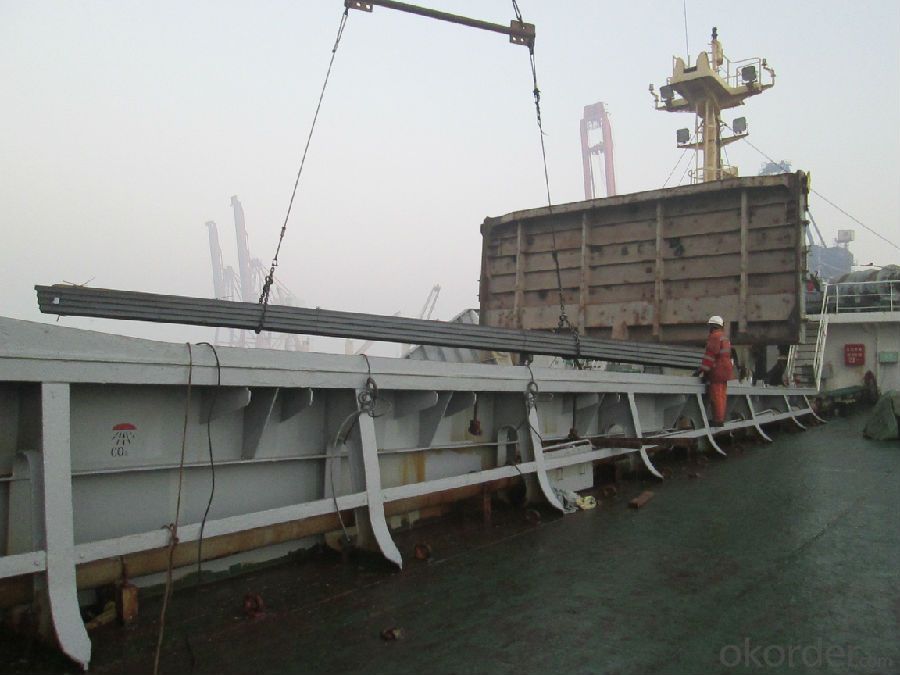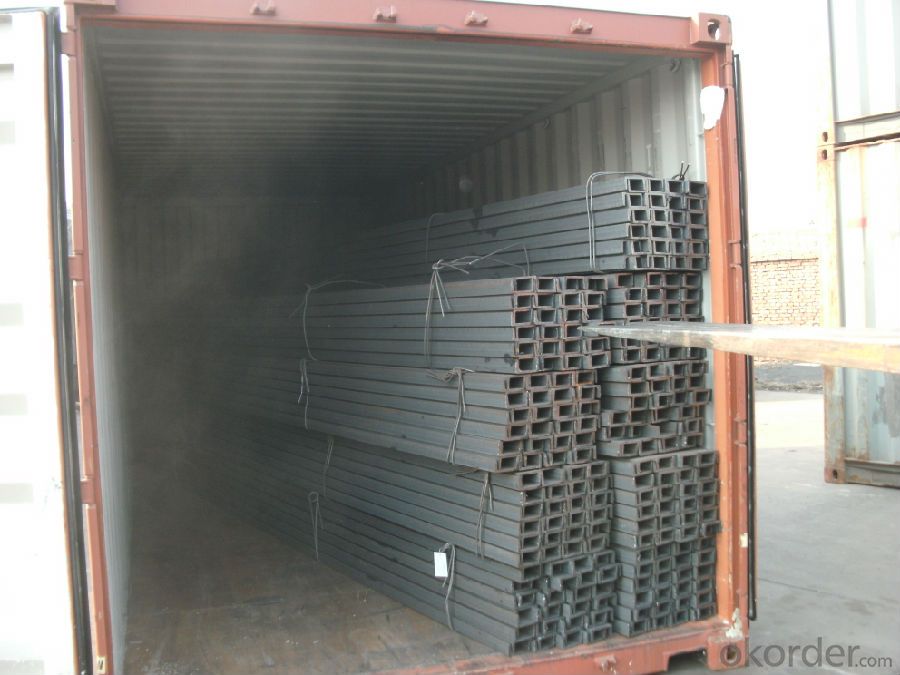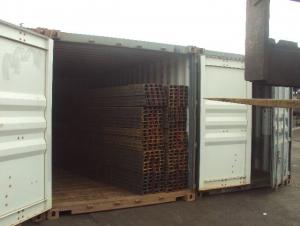U-channel JIS Standard with High Quality
- Loading Port:
- Tianjin
- Payment Terms:
- TT or LC
- Min Order Qty:
- 25 m.t.
- Supply Capability:
- 1000 m.t./month
OKorder Service Pledge
OKorder Financial Service
You Might Also Like
Product Description:
OKorder is offering U-channel at great prices with worldwide shipping. Our supplier is a world-class manufacturer of steel, with our products utilized the world over. OKorder annually supplies products to European, North American and Asian markets. We provide quotations within 24 hours of receiving an inquiry and guarantee competitive prices.
Product Applications:
1.The JIS channel can be devided into two kinds, namely common channel steel and light channel steel. The sizes of hot rolled common channel steel range from 5# to 40#. Meanwhile, the channel steel can be divided into cold forming sectional equal channel steel, cold forming sectional unequal channel steel, cold forming inner edge channel steel and outer edge channel steel.
2.The JIS channel is usually used for arch-itechtural structure, and they could be welded in order to support or hang a vari-ety of facilities. They are also usually used in combination with I beam. The channel steel with sizes under 14# is usually applied to construction engineering, as purline, while the channel steel with sizes above 16# is more likely to be used in building vehicle chassis structure and mechanical structure. Furthermore, the channel steel in sizes above 30# are target at building bridge structure, as tension bar.
3.In a word, the channel steel must possess perfect welding property, riveting property and mechanical property and so on.
Product Advantages:
OKorder's U-channel are durable, strong, and resist corrosion.
Main Product Features:
· Premium quality
· Prompt delivery & seaworthy packing (30 days after receiving deposit)
· Corrosion resistance
· Can be recycled and reused
· Mill test certification
· Professional Service
· Competitive pricing
Product Specifications:
1. We are definitely speciallizing in manufacturing and supplying channel steel as per japanese standard, which is characterised with high mechanical strength and competitive prices.
2. The sections in details are as followings in the table-1
JIS CHANNEL | Standard h | Sectional b | Dimension s | t | Mass: Kg/m |
(mm) | (mm) | (mm) | (mm) | ||
50x25 | 50 | 25 | 3.0 | 6.00 | 2.37 |
75X40 | 75 | 40 | 3.8 | 7.00 | 5.30 |
75X40 | 75 | 40 | 4.0 | 7.00 | 5.60 |
75X40 | 75 | 40 | 4.5 | 7.00 | 5.85 |
75X40 | 75 | 40 | 5.0 | 7.00 | 6.92 |
100X50 | 100 | 50 | 3.8 | 6.00 | 7.30 |
100X50 | 100 | 50 | 4.2 | 6.00 | 8.03 |
100X50 | 100 | 50 | 4.5 | 7.50 | 8.97 |
100X50 | 100 | 50 | 5.0 | 7.50 | 9.36 |
125X65 | 125 | 65 | 5.2 | 6.80 | 11.66 |
125X65 | 125 | 65 | 5.3 | 6.80 | 12.17 |
125X65 | 125 | 65 | 5.5 | 8.00 | 12.91 |
125X65 | 125 | 65 | 6.0 | 8.00 | 13.40 |
150x75 | 150 | 75 | 5.5 | 7.30 | 14.66 |
150x75 | 150 | 75 | 5.7 | 10.00 | 16.71 |
150x75 | 150 | 75 | 6.0 | 10.00 | 17.90 |
150x75 | 150 | 75 | 6.5 | 10.00 | 18.60 |
150x75 | 150 | 75 | 6.5 | 10.00 | 24.00 |
200X80 | 200 | 80 | 7.5 | 11.00 | 24.60 |
FAQ:
Q1: How soon can we receive the product after purchase?
A1: Within three days of placing an order, we will begin production. The specific shipping date is dependent upon international and government factors, but is typically 7 to 10 workdays.
Q2: What makes stainless steel stainless?
A2: Stainless steel must contain at least 10.5 % chromium. It is this element that reacts with the oxygen in the air to form a complex chrome-oxide surface layer that is invisible but strong enough to prevent further oxygen from "staining" (rusting) the surface. Higher levels of chromium and the addition of other alloying elements such as nickel and molybdenum enhance this surface layer and improve the corrosion resistance of the stainless material.
Q3: Can stainless steel rust?
A3: Stainless does not "rust" as you think of regular steel rusting with a red oxide on the surface that flakes off. If you see red rust it is probably due to some iron particles that have contaminated the surface of the stainless steel and it is these iron particles that are rusting. Look at the source of the rusting and see if you can remove it from the surface.
Images:


- Q:Small Huxing, suitable for what modeling ceiling, channel across 4.8 meters, 60cm file, middle angle steel, 60cm first gear, what kind of modeling ceiling?
- If the storey is still very high, you can directly consider the normal shape ceiling, such as: back ceiling, arc shaped ceiling, two ceiling, etc..
- Q:Can steel channels be used in residential construction?
- Indeed, residential construction can incorporate steel channels. These steel channels, which possess a C-shaped cross-section, serve as structural supports made of steel. In the realm of building construction, they are widely utilized for the purpose of providing stability and support to diverse elements like walls, floors, and roofs. The utilization of steel channels in residential construction yields numerous benefits, including their exceptional strength-to-weight ratio, durability, and resistance to fire, rot, and pests. Moreover, they exhibit versatility and find usefulness in a range of applications such as framing, wall studs, and roof trusses. Furthermore, the adaptability of steel channels allows for easy customization and cutting to specific lengths, rendering them suitable for various building designs and requirements.
- Q:18# channel perimeter
- Channel 18#A 180*68*7.0 theory weight 20.174, section area 25.69, channel 18#B 180*70*9.0 theory weight 23, section area 29.29, average leg thickness 10.5, inner arc radius 10.5, leg end arc radius 5.25
- Q:How do steel channels contribute to the overall daylighting of a building?
- Steel channels do not directly contribute to the overall daylighting of a building. Steel channels are structural components used in construction, specifically in framing and support systems. However, the overall daylighting of a building is determined by the design and placement of windows, skylights, and other transparent or translucent elements that allow natural light to enter the space.
- Q:What are the fire rating requirements for steel channel structures?
- The fire rating requirements for steel channel structures depend on various factors, including the building code, the type of occupancy, and the specific purpose of the structure. In general, steel channel structures are designed to have certain fire resistance capabilities to ensure the safety of occupants and to prevent the spread of fire. Building codes typically specify the required fire ratings based on the occupancy classification and the height of the structure. For example, in the United States, the International Building Code (IBC) outlines different fire resistance requirements for different types of buildings, such as residential, commercial, or industrial. The fire rating of a steel channel structure refers to the amount of time it can withstand the effects of fire without compromising its structural integrity. The fire rating is usually expressed in terms of minutes or hours. A higher fire rating means that the steel channel structure can withstand fire for a longer period, providing more time for evacuation and firefighting efforts. To achieve the required fire rating, various methods can be employed. One common approach is to apply fire-resistant materials, such as fire-rated gypsum board or intumescent coatings, to the steel channels. These materials can provide insulation and protect the steel from the high temperatures during a fire. Additionally, structural engineers may design steel channel structures with specific fire-resistant features, such as fireproofing coatings, fire barriers, or fire-resistant insulation. These measures help to prevent the rapid spread of fire and minimize the damage caused by heat. It is important to consult the local building code and engage a qualified structural engineer to determine the specific fire rating requirements for steel channel structures in a particular jurisdiction. Adhering to these requirements ensures that the structure meets the necessary safety standards and can withstand fire incidents effectively.
- Q:Can steel channels be used for cable tray systems?
- Steel channels are indeed suitable for cable tray systems. They offer a sturdy and long-lasting support structure for cable trays. Typically manufactured from galvanized steel, they possess exceptional resistance to corrosion, making them suitable for various indoor and outdoor uses. Furthermore, their high load-bearing capacity allows them to bear heavy cable loads without experiencing any deformation or failure. Moreover, steel channels can be effortlessly fabricated and tailored to meet specific project needs, such as varying widths, depths, and lengths. In conclusion, steel channels are a dependable and extensively utilized option for cable tray systems.
- Q:Can steel channels be used in conjunction with other building materials?
- Yes, steel channels can definitely be used in conjunction with other building materials. Steel channels are versatile structural components that are commonly used in construction projects. They can be used in combination with various building materials such as concrete, wood, and bricks. When used with concrete, steel channels are often embedded or attached to provide additional strength and reinforcement. This combination is commonly used in the construction of bridges, high-rise buildings, and other structures that require enhanced load-bearing capacity. Steel channels can also be used with wood to create hybrid structures. This combination is often seen in the construction of roof trusses and floor joists, where steel channels are integrated with wooden beams to provide a stronger and more durable framework. In addition, steel channels can be used with bricks to create sturdy and stable structures. They can be embedded within brick walls to reinforce the overall structure, especially in areas that are prone to earthquakes or high wind loads. Overall, the use of steel channels in conjunction with other building materials allows for greater flexibility and strength in construction projects. The combination of different materials can help optimize the structural integrity and performance of buildings, ensuring their durability and safety.
- Q:Can steel channels be used for industrial applications?
- Yes, steel channels can definitely be used for industrial applications. Steel channels are versatile structural components that are commonly used in various industrial settings. They are typically made from hot-rolled steel and are available in different sizes and shapes to accommodate different industrial requirements. Steel channels are often used for structural support in buildings, bridges, and other infrastructure projects. They provide excellent strength and stability, making them suitable for withstanding heavy loads and harsh environmental conditions. Steel channels are also commonly used in the construction of platforms, walkways, and staircases, providing a secure and robust framework for industrial access and safety. Furthermore, steel channels are frequently employed in the manufacturing sector for machinery, equipment, and storage systems. They are utilized to create frames, frames, and supports for conveyor belts, shelving units, and racking systems. Steel channels offer the necessary rigidity and durability to ensure the stability and longevity of industrial equipment. In addition to their structural applications, steel channels can also be used for electrical and plumbing installations in industrial settings. They can serve as raceways or conduits for electrical wiring and piping systems, providing a safe and organized solution for routing utilities and cables. Overall, steel channels offer a wide range of benefits that make them highly suitable for industrial applications. Their strength, versatility, and durability make them a reliable choice for supporting structures, machinery, and various industrial systems.
- Q:How do steel channels perform in seismic conditions?
- Steel channels perform well in seismic conditions due to their high strength and flexibility. The structural properties of steel make it resilient to ground motion, allowing channels to absorb and dissipate seismic energy. Additionally, steel's ductility helps channels withstand deformation without catastrophic failure, enhancing their overall performance in earthquake-prone areas.
- Q:How is a steel channel made?
- Hot rolling is the typical method used to produce a steel channel. The process commences by heating a large rectangular steel billet until it reaches a malleable temperature. Subsequently, the billet is passed through a sequence of rollers that gradually transform it into the desired channel shape. Throughout the hot rolling process, the rollers continually squeeze and elongate the billet, resulting in a reduction in thickness and an increase in length. The final shape of the channel is determined by the grooves on the rollers. The channel section can range from a simple C-shape to more intricate U-shapes or even customized profiles. As the billet takes shape, any surplus material is expelled through the sides, leaving behind a well-defined and clean channel shape. To prevent warping or distortion during the rolling process, the channel is consistently cooled. Once the desired length is attained, the channel is cut into individual pieces according to the specific requirements of the customer. Following the hot rolling process, additional treatments may be applied to the steel channels, such as straightening, surface cleaning, or coating. These treatments ensure that the channels meet the desired specifications and are ready for use in various applications, including structural support, construction, and manufacturing. In summary, the hot rolling process plays a vital role in the production of steel channels, enabling the fabrication of sturdy and adaptable structural components that find application in multiple industries.
1. Manufacturer Overview |
|
|---|---|
| Location | |
| Year Established | |
| Annual Output Value | |
| Main Markets | |
| Company Certifications | |
2. Manufacturer Certificates |
|
|---|---|
| a) Certification Name | |
| Range | |
| Reference | |
| Validity Period | |
3. Manufacturer Capability |
|
|---|---|
| a)Trade Capacity | |
| Nearest Port | |
| Export Percentage | |
| No.of Employees in Trade Department | |
| Language Spoken: | |
| b)Factory Information | |
| Factory Size: | |
| No. of Production Lines | |
| Contract Manufacturing | |
| Product Price Range | |
Send your message to us
U-channel JIS Standard with High Quality
- Loading Port:
- Tianjin
- Payment Terms:
- TT or LC
- Min Order Qty:
- 25 m.t.
- Supply Capability:
- 1000 m.t./month
OKorder Service Pledge
OKorder Financial Service
Similar products
New products
Hot products
Related keywords





























